In which we slow down and take a closer look
at Stieglitz and Loy’s submissions to The Blind Man
Let’s first direct the spotlight on Stieglitz’s letter. Its placement at the end of the issue lends authority to the letter, giving Stieglitz the final word and implying that his position is not ironic.
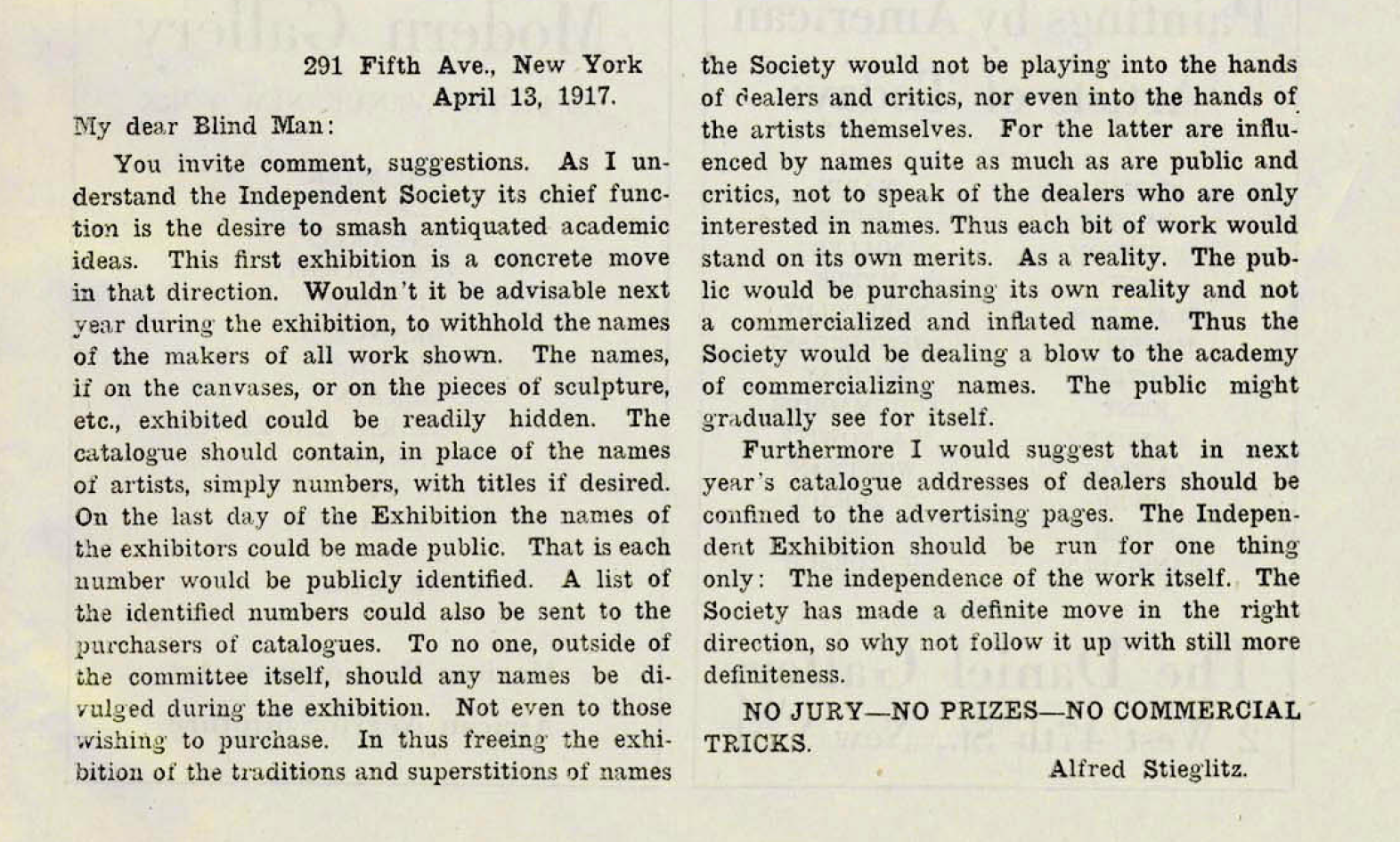
Recommending the withholding of “the names of the makers of all work shown,” Stieglitz assumes a staunchly anti-commercial stance. “[I]n thus freeing the exhibition of the traditions and superstitions of names,” he argues, the Society would allow “each bit of work” to “stand on its own merits. As a reality.”1 Isolating the phrase “as a reality” in its own sentence, Stieglitz syntactically effects a separation of art from other systems of meaning and value. “As a reality,” the work of art is no longer a commodity; it exists as its own value system, distinct from the selling power of an artist’s name and reputation.
Stieglitz’s anti-commercial stance rests on democratic principles. He wants to remove the middlemen—the critics, dealers, and even the artists—who stand in the way of the people’s direct response to art. Instead of being blinded and star-struck by the allure of “a commercialized and inflated name,” he insists, “the public might gradually see for itself” (Stieglitz 15).
Stieglitz’s letter champions the democratic ideals asserted in Henri Pierre Roché’s manifesto for The Blindman I. There, Roché praises the Independents’ exhibition for extending “equal opportunity” to all; for representing all schools “from the most conservative to the most radical”; and for encouraging the American public “to think for itself, and no longer accept, mechanically, the art reputations made abroad.”2 By thinking for itself, the American public effectively becomes a co-creator of its own art, rather than a mindless consumer of “reputations made abroad.”
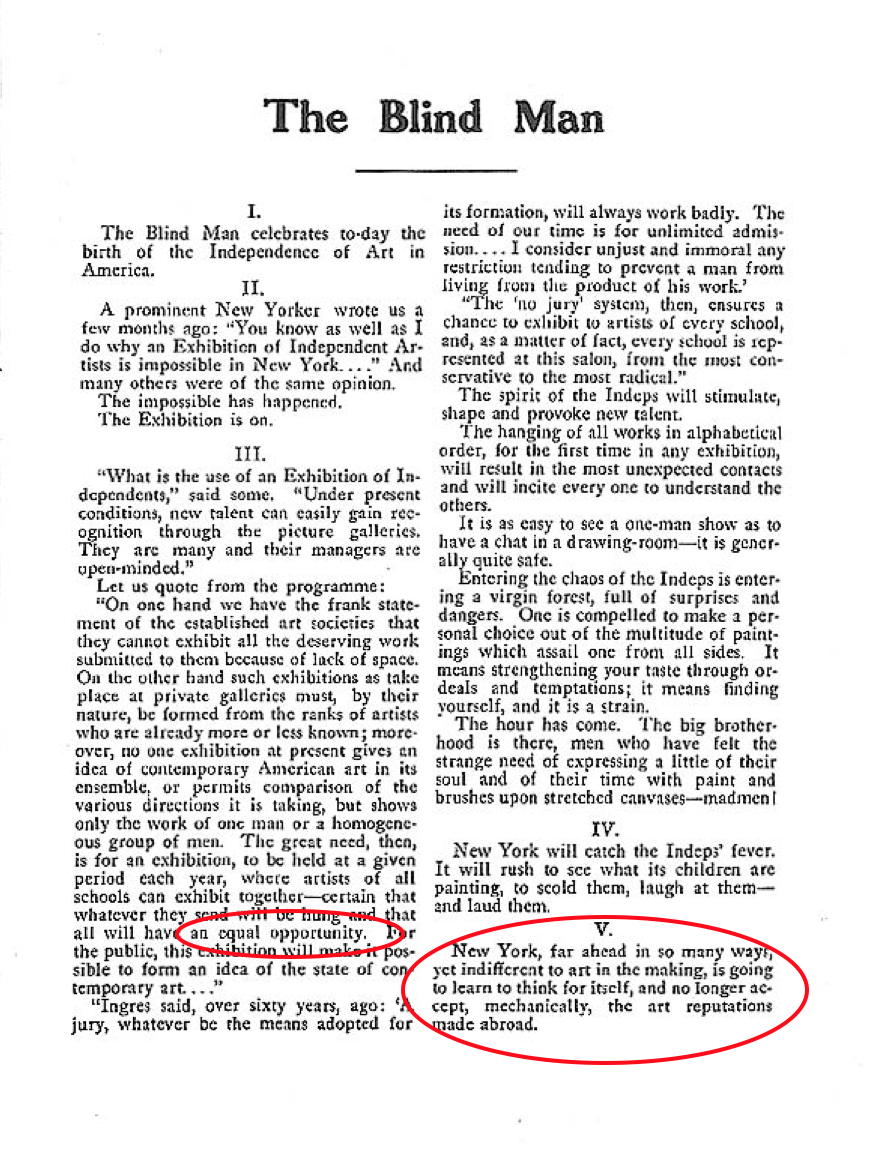
Like Roché’s manifesto, Stieglitz’s letter attempts to extricate American democratic ideals from the capitalist economy and put them in service of art.3
If Stieglitz’s idealistic goals are impossible to reach, Loy’s experimental prose is almost impossible to read. The chief allure of “O Marcel – – – otherwise I Also Have Been to Louise’s” is the enticement of eavesdropping on an exclusive event—as if “otherwise” you also have been to the ball. But if the goal is to figure out what went on, once we gain entrée to the scene, we discover that very little happens.
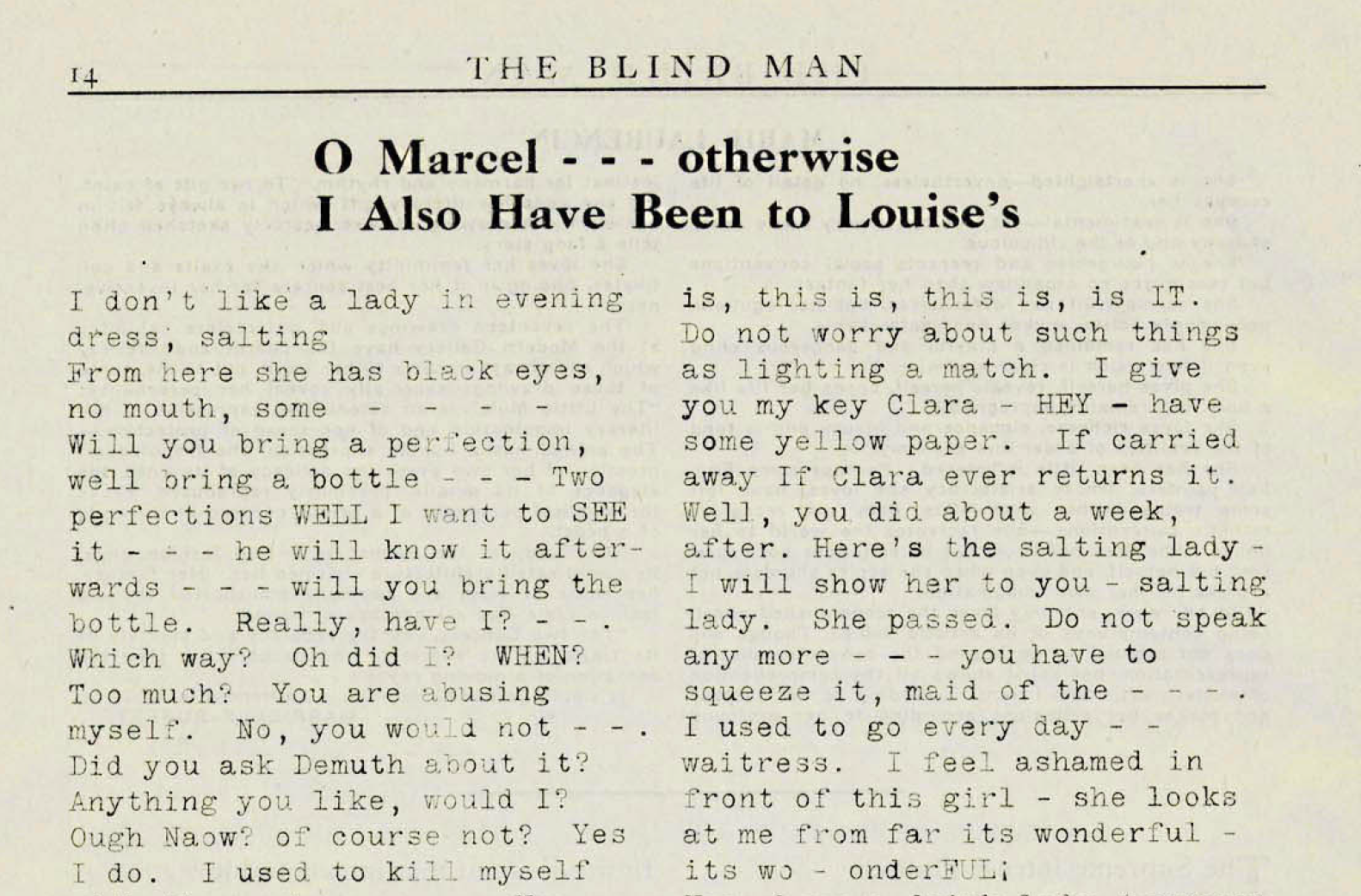
“Marcel”—assuming that the transcript records his utterances—demands a bottle (3 times), gives paper to “Mina” (3 times), gossips about a “salting lady” (3 times), and orders a tongue sandwich (5 times). The repeated references to “salting” and “tongues” may pique our interest, but they don’t satisfy our appetite for knowledge.4
To add to the frustration, the names that are sprinkled through the composition do not seem to stick to anybody or clarify personalities. Someone remarks, “You speak like Carlo well when he wants to imitate” (15). If someone is speaking like Carlo when he is imitating someone else, then identity is not authentic, but merely a copy of a copy in a chain of reproduction that does not lead to an original. Indeed, the compilation concludes with someone quoting someone else, saying,
what shall I say. Ti li li laere – she said – all right! (15)
How do we make sense of this nonsense? Loy’s work presents several interpretative possibilities.
1. An Insider’s Joke
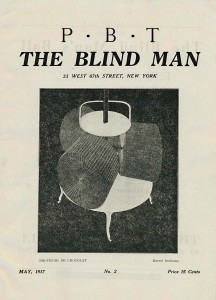 Perhaps it’s just an “insiders” joke for the Arensberg circle, whose members could have the fun of decoding the cryptic utterances and recreating the scene for their own amusement. Interpreted this way, the avant-garde is talking to itself about itself, aggrandizing its own activities through both explicit and coded self-references. The giant letters “P.B.T.,” which appear on the cover of The Blind Man reinforce this interpretation, as they refer cryptically to magazine’s instigators, Pierre Roché, Beatrice Wood, and “Totor,” Roché’s nickname for Duchamp (Watson 318). Stephen Voyce argues that Loy’s “reference to Duchamp in the title [“Oh Marcel…”] makes it likely that he is the one speaking (at least for most of the text)”, but the profusion of names, polyglot nature of the transcript, and party setting suggest that the disparate utterances come from various drunken revelers.5 If the text is, as Sarah Hayden suggests, a collage of voices “embedded with knowing winks and nods to a coterie cognoscenti”, readers outside the circle would remain in the dark—“blind” to the insiders’ joke.6
Perhaps it’s just an “insiders” joke for the Arensberg circle, whose members could have the fun of decoding the cryptic utterances and recreating the scene for their own amusement. Interpreted this way, the avant-garde is talking to itself about itself, aggrandizing its own activities through both explicit and coded self-references. The giant letters “P.B.T.,” which appear on the cover of The Blind Man reinforce this interpretation, as they refer cryptically to magazine’s instigators, Pierre Roché, Beatrice Wood, and “Totor,” Roché’s nickname for Duchamp (Watson 318). Stephen Voyce argues that Loy’s “reference to Duchamp in the title [“Oh Marcel…”] makes it likely that he is the one speaking (at least for most of the text)”, but the profusion of names, polyglot nature of the transcript, and party setting suggest that the disparate utterances come from various drunken revelers.5 If the text is, as Sarah Hayden suggests, a collage of voices “embedded with knowing winks and nods to a coterie cognoscenti”, readers outside the circle would remain in the dark—“blind” to the insiders’ joke.6
2. A Joke on the Insiders
But perhaps the joke is on the insiders, reflecting Loy’s tendency to implicate herself in her satires. Cryptic as it may be, Loy’s fractured transcript exposes the antics of the avant-garde to public scrutiny, much in the way her plays of this period do. In this way, the transcript may be interpreted as a satire of the New York avant-garde, what Hayden describes as a “portrait of the debauched debutantes of the Blind Man’s Ball” (Hayden 104). Loy may be “pointing out the hollowness of fashionable life,” as Carolyn Burke argues she does in her play The Pamperers, which begins with a similar collection of “tag ends of overheard conversation.”7
Understood as a satire of the self-promoting and celebrity-seeking avant-garde, Loy’s “O Marcel” moves into alignment with Stieglitz’s attack on “commercialized and inflated names.” In Loy’s portrait of the avant-garde, names prove to be as hollow as the people they refer to—counterfeit coins circulating in a false value system. The flagrant name-dropping generates a state of polynymity, in which the mechanical overproduction of monikers depreciates their value and removes them from the persons they refer to. Detached from their owners, names effectively become non-names, or anonyms. In this way, Loy’s polynymous transcript provides a satiric answer to Stieglitz’s call for anonymous submissions to the Independents’ Exhibition.
3. A New American Art Form
Yet if it’s just a joke on the avant-garde, why the unconventional form? Loy seems to be conducting an experiment in a new American form, attempting to document modern life as it happens. Understood as a “slice of life” in the New York avant-garde, Loy’s experiment fulfills the program for art outlined by Frank Crowninshield a few pages earlier in Blind Man: a truly native American art, Crowninshield argues, “must very closely embody the spirit of our time, however morbid, however hurried, however disorganized, however nerve-racking that time may be.”8
Loy’s “O Marcel” is a record of its time—a hurried, disorganized transcript of the New York avant-garde in the spring of 1917. Cristanne Miller describes the transcript as “narrative collage,”9 and Voyce says that Loy uses the collage form “to construct mobile constellations of bodies and objects, consciously emphasizing exchange, movement, and transition” (Voyce 642-4). But Marjorie Perloff dissents, arguing that,
Loy was not a collagiste. She does not paste together disparate verbal fragments, letting their spatial juxtapositions create a complex network of meanings. Rather hers is a temporal mode, a satiric narrative, however broken and self-interrupting, in which structures of voice and address take precedence over…the Image.10
In “O Marcel,” patterns of “voice and address take precedence” over any concrete visual scene. The transcript emphasizes sound patterns, accents, and pronunciations, and patterns in the cacophony suggest a preoccupation with accent and conversation:
You are Pennsylvania I am Boston. Do you want some cigarettes – – Did you put the pronunciation.” (15)
Loy seems interested in recording the process by which verbal utterances both constitute personal identity and dissolve it in a performative mix of postures, poses, and pronunciations.11
Loy’s experiment moves into even closer alignment with Stieglitz if we interpret it as the verbal equivalent of a snapshot, not a photograph but a sonograph—a new form of sound writing. According to Marissa Januzzi, “‘O Marcel’ is a sort of experiment [Loy] never tried (for publication) again, a bit of verbal easel-painting that seems quite directly to (re)present a slice of conversation among members of the Arensberg circle at the Blindman’s Ball…”12 Loy’s interest in conversation suggests that her experiment is not so much easel painting, however, as sound recording. Moreover, the signature line, “compiled by Mina Loy,” suggests that Loy has not written these remarks, but simply found them, recorded them, and placed them in a new context.13
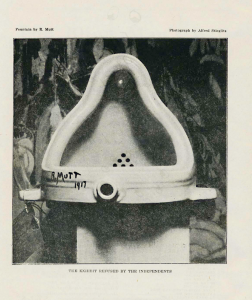 In this way, “O Marcel” is analogous to a readymade, or more precisely, to the readymade that is the center piece and focal point of Blind Man 2: R. Mutt’s Fountain.14 Like the urinal overturned, signed with a pseudonym, submitted as a work of art, photographed by Stieglitz, and reprinted on page 4 of Blind Man 2, Loy’s “O Marcel” calls into question the authenticity of the work of art—as well as the artist, who is no longer a God-like creator, but a human collector, or merely a mechanical compiler.
In this way, “O Marcel” is analogous to a readymade, or more precisely, to the readymade that is the center piece and focal point of Blind Man 2: R. Mutt’s Fountain.14 Like the urinal overturned, signed with a pseudonym, submitted as a work of art, photographed by Stieglitz, and reprinted on page 4 of Blind Man 2, Loy’s “O Marcel” calls into question the authenticity of the work of art—as well as the artist, who is no longer a God-like creator, but a human collector, or merely a mechanical compiler.
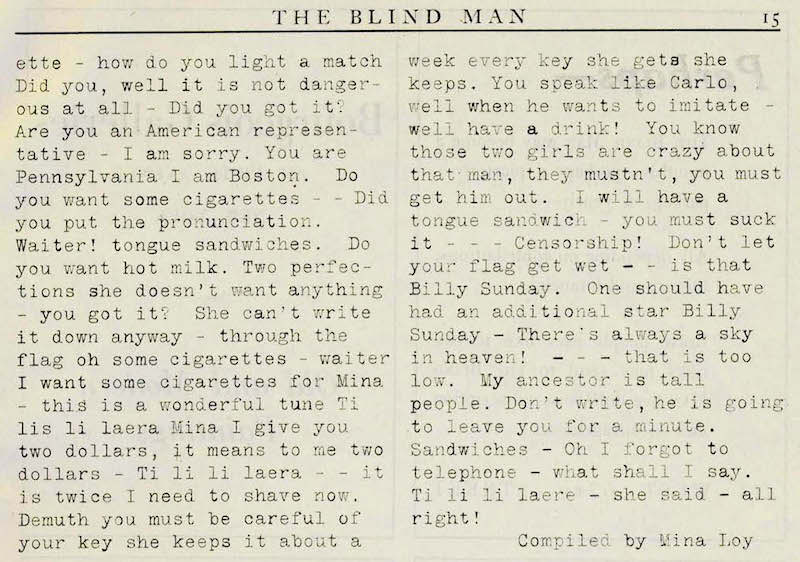
The typeface used for Loy’s sonograph resembles a typewriter or telegram—modern, mechanical forms for recording and communicating information quickly. The “typewriter” font used exclusively in the sonograph highlights its mechanical character and presents a vivid contrast to the traditional printer’s font used in Stieglitz’s adjacent letter and other articles in the magazine.
“Is he serious or is he joking?” anxious art-lovers ask in response to R. Mutt’s Fountain. To which Louise Norton replies in defense of the work, “Perhaps he is both! Is it not possible?”15 The same could be said of Loy’s “O Marcel,” which may be any or all these things: an insiders’ joke, a joke on the insiders, a serious artistic experiment, and a challenge to the aesthetic, moral, and commercial conventions that govern the art world. “It puts it rather up to you,” Norton says (6). In turning her unconventional work over to the public to interpret, and in divesting the author’s name of originality and ownership, Loy falls in step with Stieglitz on the Dada stage, even as she choreographs her own en dehors garde moves.
- Alfred Stieglitz, “My dear Blind Man,” The Blind Man, No. 2 (May 1917), 15.
- Henri Pierre Roché, “The Blind Man.” The Blindman: Independents’ Number, No. 1 (Apri. 10, 1917), p.3.
- In this effort, Stieglitz and Roché were in sympathy with contemporary American social critics Van Wyk Brooks, Randolph Bourne, and H. L. Mencken, who together mounted an attack on Puritanism, which they viewed as inhibiting the development of an American literary tradition. They associated Puritanism not only with sexual prudery, but also with mass culture, commercialization, materialism, and Anglo-Saxonism. According to their logic, the puritan impulse prevented writers from grappling with the unrefined, unsavory aspects of everyday American life, and resulted in a literature that was moralistic, sentimental, and imitative of English models. See Arthur Frank Wertheim, The New York Little Renaissance: Iconoclasm, Modernism, and Nationalism in American Culture, 1908-1917 (New York: New York University Press, 1976), 3-15; Randolph S. Bourne, War and the Intellectuals: Essays by Randolph S. Bourne, 1915-1919, edited by Carl Resek (New York: Harper & Row, 1964); Van Wyk Brooks, America’s Coming of Age (New York: Viking, 1930); and H. L. Mencken, A Book of Prefaces (Garden City, NY: Garden City Publishing, 1927).
- The mysterious “salting lady” may be a coded reference to “salt cellar”—in French, “marchand du sel,” a transposition of “Marcel Duchamp,” that became the title of Duchamp’s collected writings and was playfully translated into English as “salt seller.” If intended, this multilingual pun only multiplies the play of names to dizzying extremes. Salt Seller; the Writings of Marcel Duchamp. Marchand du sel, edited by Michel Sanouillet and Elmer Peterson (New York, Oxford University Press, 1973).
- Stephen Voyce, “‘Make the World Your Salon’: Poetry and Community at the Arensberg Apartment,” Modernism/modernity 15, no. 4 (2008): p.641.
- Sarah Hayden, Curious Disciplines: Mina Loy and Avant-Garde Artisthood, Albuquerque, NM: University of New Mexico Press, 2018, p.108.
- Carolyn Burke, Becoming Modern: The Life of Mina Loy. New York: Farrar Straus & Giroux, 1996, p.222-3.
- Frank Crowninshield, “From a Friend,” The Blind Man, No. 2 (May 1917), p.10.
- Cristanne Miller, Cultures of Modernism: Marianne Moore, Mina Loy and Else Lasker-Schüler, Gender and Literary Community in New York and Berlin, University of Michigan Press, 2007, p.72.
- Marjorie Perloff, “English as a Second Language: ‘Anglo-Mongrels and the Rose’,” In Mina Loy: Woman and Poet, Ed. by Maeera Schreiber and Keith Tuma, Orono, ME: National Poetry Foundation, 1998, p.144
- Loy explores similar issues in her plays The Sacred Prostitute and The Pamperers, as well as in her 1925 essay “Modern Poetry,” which describes modern poetry as emerging from the rhythm and sounds of American vernacular—”English enriched and variegated with the grammatical structure and voice-inflection of many races, in novel alloy with the fundamental time-is-money idiom of the United States, discovered by the newspaper cartoonists” (LLB96 158).
- Marissa Januzzi, “Dada Through the Looking Glass, or: Mina Loy’s Objective,” In Women in Dada: Essays on Sex, Gender, and Identity, Ed. by Naomi Sawelson-Gorse, Cambridge, MA: The MIT Press, 1998, p.583.
- Sarah Hayden comes closest to this view of the transcript, noting that “it presents itself as a speech sample apparently selected and proffered to the reader without curatorial intrusion” (106). But Hayden also cunningly observes that while the verb “compiled” “denies authorial responsibility,” the proper noun “Mina Loy” “makes a claim for the recognition of the compiler” (106). In this way, the text is typically multivalent, undercutting its own claims to dissolve artistic identity by acknowledging the experiment as an act of avant-garde hubris.
- Significantly, Duchamp also used his signature to undermine the authenticity of the artist as creator of the readymade. For example, he inscribed a snow shovel, “In Advance of a Broken Arm / From Marcel Duchamp.” As Michael R. Taylor argues, “the idea of the piece being ‘from’ rather than ‘by’ the artist was important, since the French ‘de’ did not carry his intended meaning, which was to lose the concept of art as a manual, handcrafted enterprise” (206-7).
- Louise Norton, “Buddha of the Bathroom,” The Blind Man, No. 2 (May 1917), p.6.